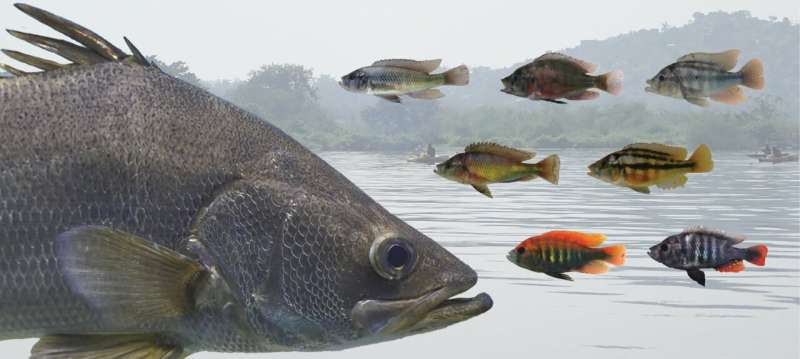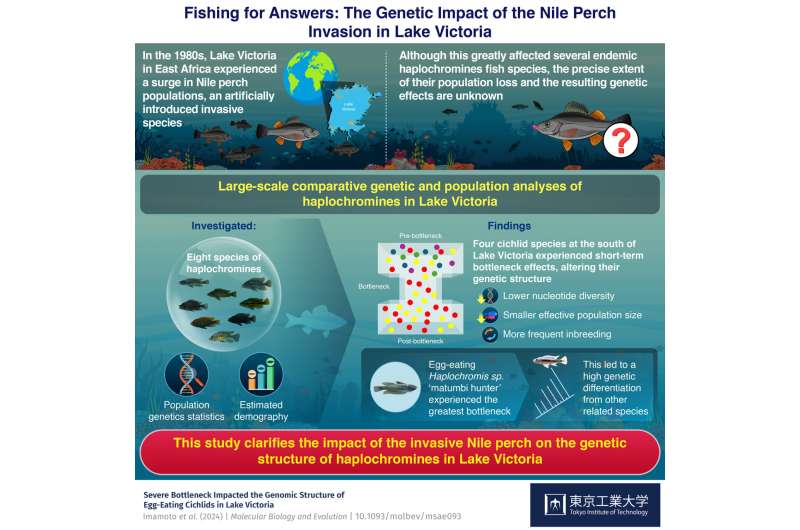This article has been reviewed according to Science X's editorial process and policies. Editors have highlighted the following attributes while ensuring the content's credibility:
fact-checked
peer-reviewed publication
trusted source
proofread
Nile perch invasion triggered genetic bottlenecks in lake Victoria's endemic cichlids, analyses suggest

Newfound evidence reveals that the upsurge of the exotic Nile perch in Lake Victoria had long-lasting effects on the genetic diversity of various local cichlid species, report scientists from Tokyo Tech. Through large-scale comparative genomic analyses, the researchers found concrete proof in the collective genome of multiple species that this artificially introduced perch decimated many local fish populations, causing a "bottleneck effect."
The careless introduction of exotic species by humans into ecosystems can lead to truly catastrophic results, as has been proven time and time again. One tragic example is the introduction of the Nile perch, a large freshwater fish found in waterbodies in Africa, into Africa's largest lake—Lake Victoria.
Brought to Lake Victoria in the 1950s to meet commercial demand for its meat, the Nile perch devastated native populations of fish known as haplochromine cichlids. By the 1990s, experts estimated that more than 200 species of endemic cichlids had been driven to extinction by this fierce predator.
Interestingly, the remaining species could also have been deeply affected by the severe population loss caused by the Nile perch, since such events tend to reduce the genetic diversity of surviving groups. However, how much the genetic structure of cichlids was affected by the introduction of the Nile perch remains unclear.
Against this backdrop, a research team from Tokyo Institute of Technology (Tokyo Tech), The Graduate University for Advanced Studies, SOKENDAI in Japan and Tanzania Fisheries Research Institute in Tanzania decided to shed some light on the issue.
In their latest study, which was published in Molecular Biology and Evolution, the researchers conducted large-scale comparative genomics analyses on multiple species of cichlids endemic to Lake Victoria, which provided detailed insights into the effects of the invasive Nile perch since its introduction to this environment. The team included Associate Professor Masato Nikaido and doctoral student Minami Imamoto from Tokyo Tech.

Through a genomic analysis that included 137 haplochromine species, the researchers discovered that four species from the Mwanza Gulf (located in the southern part of the lake) experienced what is known as a "bottleneck event." In simple terms, the population of these species was reduced so much that the genetic diversity within the population had significantly decreased.
Further investigation by the researchers painted the Nile perch as the culprit for the observed changes in the genetic structure of these four species. "The timing of the bottleneck, which began during the 1970s–1980s and ended by the 1990s–2000s, corresponded to the historical records of these endemic haplochromines' disappearance and later resurgence," explains Nikaido. "This is likely associated with the introduction of Nile perch by commercial demand to Lake Victoria in the 1950s."
Out of the four species, the researchers noted that the egg-eating cichlids Haplochromis sp. "matumbi hunter" and Haplochromis microdon had experienced particularly severe bottleneck effects. For matumbi hunter, this effect was so pronounced that its genome had diverged significantly even from those of closely related species.
"Our findings support the previously existing hypothesis that carnivorous fishes, including egg-eaters, should have experienced a stronger bottleneck," remarks Nikaido, "This study presents, for the first time, the impacts of the Nile perch upsurge on the genetic structure of Lake Victoria haplochromines" he further adds.
Worth noting, the loss of genetic diversity due to short-term bottleneck effects can seriously hamper a species' fitness and adaptability in the long-term. Thus, taken together, these newfound insights tell a cautionary tale of just how bad the introduction of exotic species can be, even for species that survive extinction.
Researchers identified species that suffered severe damage due to the introduction of Nile perch, providing new insights into conservational biology.
Genetic evaluations can offer practical solutions for protecting local fauna, such as discovering species needing urgent protection and establishing no-fishing zones. Notably, some cichlid species, previously thought extinct, are gradually being rediscovered. Furthermore, developing conservational strategies based on comparative genomics may facilitate the resurgence of the ecosystem.
More information: Minami Imamoto et al, Severe Bottleneck Impacted the Genomic Structure of Egg-Eating Cichlids in Lake Victoria, Molecular Biology and Evolution (2024). DOI: 10.1093/molbev/msae093
Journal information: Molecular Biology and Evolution
Provided by Tokyo Institute of Technology


















